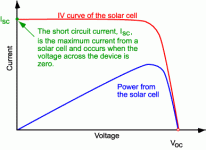shawname
1 W
captain387 said:Apparently one panel was defective and was drawing down the rest of the panels.
It was the difference between the no load vs meter reading shorted amperage.
Try each panel separately with a load connected.
Good to know even a technician can get lost!
I'll try this, shorting each panel out one by one measuring the current, and retesting all the wiring. If I don't find any problems, I will short out the whole array down at the charge controller, and see if the amperage jumps.
thank you!


